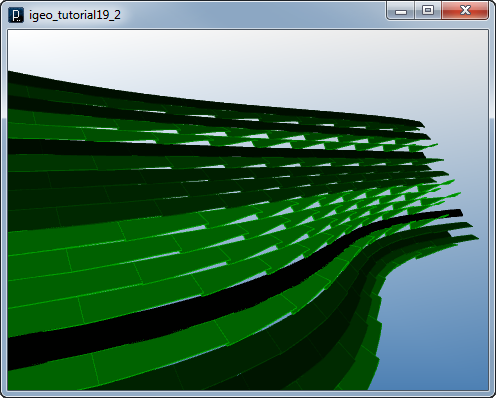

 Python Tutorials Python Tutorials | (back to the list of tutorials) |
 Panelization Example3
Panelization Example3![]()
![]()
![]()
![]()
add_library('igeo')
size(480,360,IG.GL)
IG.open("surface4.3dm")
surfaces = IG.surfaces()
for surf in surfaces :
unum = 20
vnum = 20
uinc = 1.0/unum
vinc = 1.0/vnum
for i in range(unum) :
for j in range(vnum) :
if (i+j)%2== 0 :
pts = []
pts.append([])
pts.append([])
pts[0].append(surf.pt( i*uinc, j*vinc ))
pts[0].append(surf.pt( i*uinc, (j+2.0/3)*vinc ))
pts[0].append(surf.pt( i*uinc, (j+4.0/3)*vinc ))
pts[0].append(surf.pt( i*uinc, (j+2)*vinc ))
pts[1].append(surf.pt( (i+1)*uinc, j*vinc ))
pts[1].append(surf.pt( (i+1)*uinc, (j+2.0/3)*vinc ))
pts[1].append(surf.pt( (i+1)*uinc, (j+4.0/3)*vinc ))
pts[1].append(surf.pt( (i+1)*uinc, (j+2)*vinc ))
rotAxis = pts[1][3].dif(pts[1][2])
# rotating around the center pts[1][2] and the axis rotAxis
pts[0][2].rot(pts[1][2],rotAxis,-PI/2)
# rotating around the center pts[1][3] and the axis rotAxis
pts[0][3].rot(pts[1][3],rotAxis,-PI/2)
ISurface(pts, 1, 3)
surf.del()

Then the rotation angle is randomized.
![]()
![]()
![]()
![]()
add_library('igeo')
size(480,360,IG.GL)
IG.open("surface4.3dm")
surfaces = IG.surfaces()
for surf in surfaces :
unum = 20
vnum = 20
uinc = 1.0/unum
vinc = 1.0/vnum
for i in range(unum) :
maxAngle = IRand.get(0, PI*2/3)
for j in range(vnum) :
if (i+j)%2== 0 :
pts = []
pts.append([])
pts.append([])
pts[0].append(surf.pt( i*uinc, j*vinc ))
pts[0].append(surf.pt( i*uinc, (j+2.0/3)*vinc ))
pts[0].append(surf.pt( i*uinc, (j+4.0/3)*vinc ))
pts[0].append(surf.pt( i*uinc, (j+2)*vinc ))
pts[1].append(surf.pt( (i+1)*uinc, j*vinc ))
pts[1].append(surf.pt( (i+1)*uinc, (j+2.0/3)*vinc ))
pts[1].append(surf.pt( (i+1)*uinc, (j+4.0/3)*vinc ))
pts[1].append(surf.pt( (i+1)*uinc, (j+2)*vinc ))
rotAxis = pts[1][3].dif(pts[1][2])
# rotating around the center pts[1][2] and the axis rotAxis
pts[0][2].rot(pts[1][2],rotAxis,-maxAngle*j*vinc)
# rotating around the center pts[1][3] and the axis rotAxis
pts[0][3].rot(pts[1][3],rotAxis,-maxAngle*j*vinc)
ISurface(pts, 1, 3).clr(0,maxAngle/PI,0)
surf.del()


 HOME
HOME
 FOR PROCESSING
FOR PROCESSING
 DOWNLOAD
DOWNLOAD
 DOCUMENTS
DOCUMENTS
 TUTORIALS (Java /
Python)
TUTORIALS (Java /
Python)
 GALLERY
GALLERY
 SOURCE CODE(GitHub)
SOURCE CODE(GitHub)
 PRIVACY POLICY
PRIVACY POLICY
 ABOUT/CONTACT
ABOUT/CONTACT
